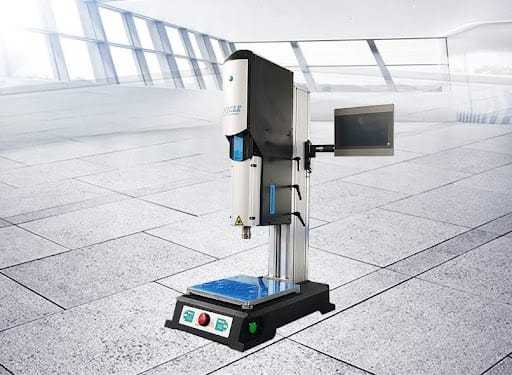Ultrasonic welding is a widely used technique for joining thermoplastics, offering speed, precision, and high-quality welds. However, not all materials are equally suited to ultrasonic welding, and one such material is Polyoxymethylene (POM), commonly known as acetal or Delrin.
POM is a highly crystalline thermoplastic, and its unique properties present challenges when using ultrasonic welding machines.
This article will explore why POM is difficult to weld using ultrasonic methods, and discuss ways to overcome these challenges and provide recommendations for selecting the right POM ultrasonic welding machine to ensure successful results.
Table of Contents
Toggle1. What Is POM and Why Is It Used in Industry?
Polyoxymethylene (POM) is a highly durable, stiff thermoplastic known for its excellent wear resistance, low friction, and high mechanical strength. It is commonly used in industries such as automotive, electronics, medical devices, and consumer goods due to its outstanding properties like dimensional stability and resistance to solvents, oils, and fuels.
However, these very attributes that make POM desirable for industrial use can also make it challenging to weld. POM is a crystalline material with a high melting point, and its structure is not as conducive to ultrasonic welding as that of more amorphous materials like polystyrene or polyethylene.
2. The Role of Crystallinity in POM Ultrasonic Welding
One of the most significant challenges when using a POM ultrasonic plastic welding machine is POM’s high crystallinity. The crystallinity of a material refers to how much of its structure is made up of ordered molecules.
In the case of POM, a high degree of crystallinity results in a rigid molecular structure that does not respond to ultrasonic vibrations as easily as more amorphous materials.
Impact of High Crystallinity on Welding
- Reduced Heat Absorption: Crystalline materials like POM have a much lower heat absorption capacity compared to amorphous plastics. When ultrasonic vibrations are applied, they generate heat at the interface of the parts being welded. In crystalline materials, this heat is not easily absorbed, which means the weld zone may not reach the required temperature for bonding.
- Higher Melting Point: The high melting point of POM (around 175°C) means that ultrasonic energy needs to generate significantly more heat to soften the material. This increases the difficulty of achieving a proper bond using a POM ultrasonic welder as compared to welding materials with a lower melting point.
- Poor Acoustic Impedance Match: For ultrasonic welding to be effective, the material being welded must have an acoustic impedance that matches the welding equipment. POM’s crystalline structure affects its impedance, making it difficult for ultrasonic waves to transfer energy efficiently. As a result, less energy reaches the material, reducing the effectiveness of the weld.
3. Challenges of Welding POM with Ultrasonic Welding Equipment
Welding POM with POM ultrasonic welding equipment presents several challenges beyond just the material’s crystallinity:
Difficulty in Achieving Uniform Melting
Since POM does not absorb heat as easily, it is harder to achieve uniform melting throughout the joint. If one area of the material melts while another remains solid, it leads to weak bonds and inconsistent welds. This is a particular issue when welding parts with uneven thickness or large surface areas.
Delamination or Cracking
When the ultrasonic vibrations do not penetrate the material effectively, stress can build up at the interface, causing the POM to crack or delaminate rather than form a solid bond. This is especially problematic in applications that require high-strength welds, such as in automotive or medical device manufacturing.
Excessive Heat Generation
In an attempt to overcome the high melting point of POM, some POM ultrasonic plastic welders might generate excessive heat, which can cause material degradation. Prolonged exposure to high temperatures can lead to material burn-out, discoloration, and a reduction in the overall strength of the welded parts.
4. Overcoming the Challenges of POM Welding
While welding POM is challenging, it is not impossible. By choosing the right approach, equipment, and techniques, it is possible to achieve strong and reliable welds. Below are some strategies to overcome the challenges of POM ultrasonic welding.
Optimizing Frequency and Power Settings
The frequency and power settings on the POM ultrasonic plastic welding machine are crucial when working with POM. Lower frequencies, typically around 20 kHz, are more effective for materials with high crystallinity like POM. These frequencies generate more heat and allow for better energy transfer to the material.
In addition, increasing the power output can help overcome the higher melting point of POM, but care must be taken to avoid overheating and causing material degradation. Using a POM ultrasonic welder with adjustable power settings allows for fine-tuning of the process to suit the specific requirements of POM.
Using Specialized Horns and Amplitude Control
The design of the welding horn also plays a critical role in the success of ultrasonic welding with POM. A plastic POM ultrasonic welder with a specially designed horn for high-crystallinity materials can help optimise the transmission of ultrasonic waves into the material.
The horn’s amplitude control should be set to the optimal level to ensure that enough energy is delivered without causing excessive heating or degradation.
Moreover, some ultrasonic welding machines allow for the use of stepped horns or boosters that can help focus the ultrasonic energy more effectively at the welding interface, which is especially useful when working with challenging materials like POM.
Preheating the Material
Another method to improve the weldability of POM is preheating. Preheating the material before welding lowers its crystallinity and reduces the amount of energy required to bring it to its melting point.
Some POM ultrasonic welding equipment includes preheating functions, which can be programmed to heat the parts before the ultrasonic welding process begins. This reduces the risk of cracking and delamination and ensures a smoother welding process.
Adjusting the Welding Time and Pressure
Shortening the welding time can help prevent excessive heat buildup, which could otherwise damage the POM material. Additionally, adjusting the pressure applied during the welding process can ensure that the material is joined without causing warping or cracking.
For best results, the pressure should be high enough to ensure intimate contact between the parts but low enough to prevent deformation of the POM. The optimal pressure setting varies depending on the specific POM ultrasonic plastic welder and the characteristics of the material being welded.
Choosing the Right Type of POM
Different grades of POM have different crystallinity levels, and some are more amenable to ultrasonic welding than others.
For instance, certain types of POM are designed to have lower crystallinity or modified polymer chains, which improve their weldability. When selecting POM for ultrasonic welding, it’s essential to choose a grade that is known to be more suitable for the process.
5. Selecting the Right POM Ultrasonic Welder
Investing in the right POM ultrasonic welding machine is crucial for achieving optimal results. Here are some features to look for when selecting a machine:
Powerful and Adjustable Output
A high-power output, with adjustable settings for frequency and amplitude, is necessary when welding high-crystallinity materials like POM. This ensures that enough energy is delivered to achieve the required melt and bond.
Customization for High-Crystallinity Materials
Machines specifically designed for difficult-to-weld plastics, such as POM, often come with features tailored for these materials. For example, custom-designed horns, advanced temperature control systems, and preheating capabilities can help improve weld quality and reduce material stress.
Quality Control Features
Some POM ultrasonic welding equipment comes with built-in monitoring and quality control features. These include sensors for measuring temperature, pressure, and time, which help ensure consistency in welds and reduce the risk of errors or defects during production.
If you’re looking for a reliable ultrasonic welder, check Dizo plate welder to learn more about machines designed for challenging materials like POM.
Conclusion
Welding POM using ultrasonic techniques presents several challenges due to its high crystallinity, high melting point, and poor heat absorption. However, with the right equipment and techniques, these challenges can be overcome.
By selecting a suitable POM ultrasonic plastic welding machine, adjusting the frequency and power settings, and employing specialized tools like preheating, customizable horns, and proper pressure control, it is possible to successfully weld POM with ultrasonic technology.
To get a reliable POM ultrasonic welding machine, investing in high-quality equipment and understanding the material’s characteristics will ultimately lead to stronger, more durable welds and more efficient production processes.








